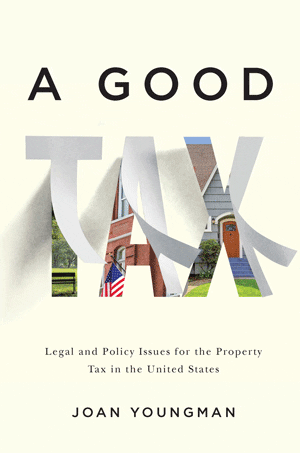A Good Tax: Legal and Policy Issues for the Property Tax in the United States
Joan Youngman
Lincoln Institute of Land Policy
113 Brattle Street, Cambridge, MA 02138;
www.lincolninst.edu.
278 pages. Paperback, $30.
Two taxes least loved by most Americans are property taxes and income taxes. In A Good Tax, Joan Youngman defends the property tax, pointing out that it “is a mainstay of independent local government revenue . . . supplies nearly half of all general revenue from local sources . . . almost all school district tax revenue” and is a more powerful revenue instrument than the federal income tax, collecting $472 billion versus $297 billion between 2005 and 2015.
An attorney and chair of the Department of Valuation and Taxation at the Lincoln Institute, Youngman presents a crisp and balanced review of the complex administrative and political challenges posed by the assessment and collection of the annual property tax. She carefully guides the reader through the tangled history of efforts to create more user-friendly taxes.
In Youngman’s view, a good property tax should be stable, efficient, and fair. It should be transparent so that taxpayers can evaluate the cost of local public services and hold public officials accountable. Its assessment should be based on market value in order to fairly and accurately distribute its burden.
Because a property tax application is popular with particular constituencies does not ensure that it is efficient, equitable, or effective. Youngman tears into tax increment financing (TIF), conservation easements, farmland assessment, and tax restrictions and assessment limits.
TIFs are the most widely used U.S. local government economic development tools. In theory, TIFs create perfect closed systems of self-sustaining finance, earmarking taxes on future property value increases in TIF districts to pay for public improvements there. Because they are located in blighted areas that would not otherwise attract private capital, TIFs justify public investment as triple wins for cities, private developers, and taxpayers.
But TIFs do not always fit good tax standards. Slippery definitions of blight allow for manipulation by politicians such as Richard M. Daley, Chicago mayor from 1989 to 2011, who saw them as “the only game in town.” By 2005, 10 percent of all property taxes in Chicago were earmarked for TIF purposes and TIF districts covered more than one-quarter of the city’s area. This caused the city’s schools, parks, and transit system to lose hundreds of millions of dollars in revenue.
Conservation easements are immensely popular, restricting over 20 million acres (8.1 million ha) of U.S. land from development as of 2014. Landowners convey perpetual conservation easements to local land trusts in return for reduced future property tax assessments. Many of these easements make scenic, environmental, or recreational contributions to public welfare.
However, conservation easements are not always transparent, with sometimes questionable assessment practices. They can also drive up costs of adjoining lands, contribute to sprawl through patchwork development patterns, prohibit public access, and inhibit land use flexibility through their inability to change with future conditions.
Preferential assessment is a popular program for lowering taxes on farmland. Owners enroll their land in order to have it assessed at “use value” based on its current agricultural use rather than on fair market value that reflects potential future uses. Advocates claim it protects family farms, preserves open space, and prevents urban sprawl. However, landowners can opt out of the program with little to no penalty, having paid minimum tax while holding their land for future sale.
Use value assessment fails Youngman’s criteria for market-based property valuation, providing a windfall to farm owners who then sell their land for future development. The unintended consequences include subsidizing development, providing tax benefits not targeted to need, and frustrating regional planning for long-term land preservation.
Tax restrictions and assessment limits were spurred nationally by California’s Proposition 13 in 1978, which made purchase price, not market value, the standard for assessment. Under this and similar laws, only modest assessment adjustments can be made for inflation, although base-year value is increased to market value upon a change in ownership.
Assessment limits keep property taxes from rising sharply, but they can create winners and losers, rewarding longtime property owners at the expense of recent purchasers. In his dissent to the U.S. Supreme Court’s denial of a Los Angeles resident’s Proposition 13 challenge, Justice Stevens wrote that “some homeowners pay 17 times as much as their neighbors with comparable property.”
Youngman’s remedy for problematic tax proposals is to insist on a fair market value basis and on transparent and visible administration. A tax computed as a percentage of value is clear and understandable. Property tax bills enable the local electorate to hold public officials accountable. While this may not satisfy all special interests, it will ensure a “good” tax for the majority.
David R. Godschalk is planning professor emeritus at the University of North Carolina at Chapel Hill and coauthor of Sustaining Places: Best Practices for Comprehensive Plans (APA Planning Advisory Service, 2015).


